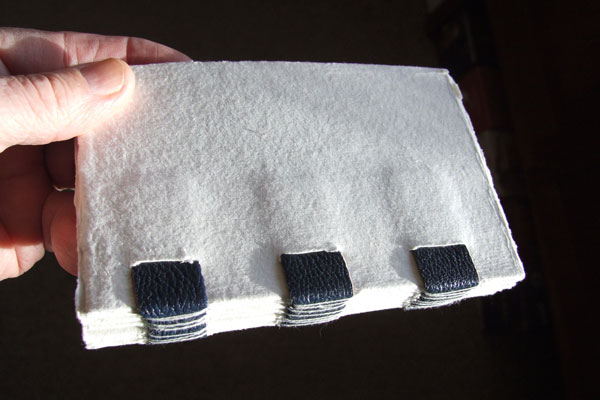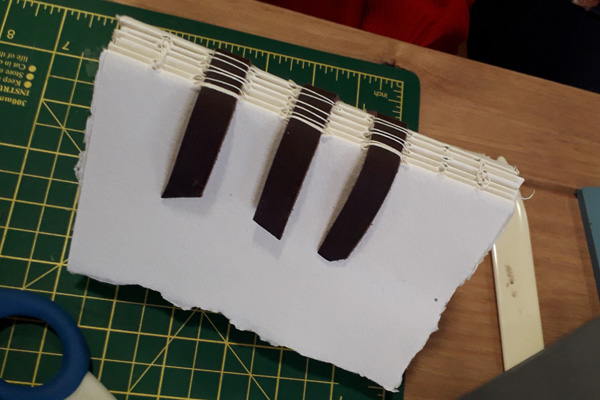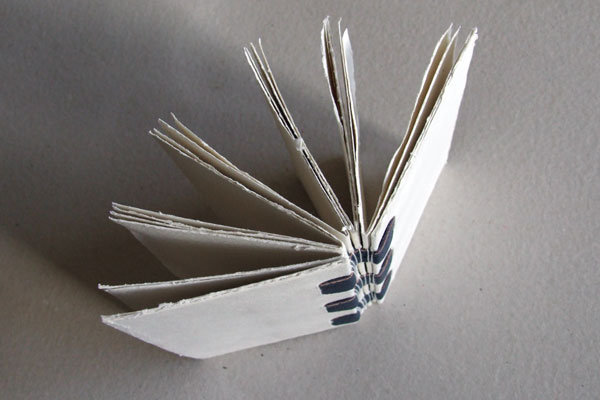
A finished Edison style book
Open back books have the advantage of being very easy to make ~ they open out flat ~ and are quite as serviceable as any other binding method. They do not look anything like books bound in the traditional library style. They provide opportunity for some ornamentation with the stitching. We have a variety of descriptors and a comprehenisve guide as to the specifications is available under the title Boole Books [114045].

This page provides the specifications for one specific set of materials and techniques. The pictures may show slight variations ~ they are not all of the same book.

The book is made with handmade tub sized all-cotton-rag acid-free paper made by Khadi in Karala, India [120729]. The leather is three strips of unrecorded origin ~ used 'as available' ~ colour unspecified but usually dark ~ thickness about 1mm. The sewing is done with 18/5 waxed linen thread ~ thicker than necessary but felt to be appropriate.
If buying the Edison Kit ~ or an Edison book ~ the size is approximately A6. The paper used is 320 gsm and the book comprises five sections each of two folios. That makes 20 leaves or 40 sides ~ although they are not numbered. The covers are additional and are made-up to be 640gsm board. The paper is cobble-cut from larger sheets [121970]. The lay-edge [116270] is the top edge.

A suitable needle to take type 18/5 thread ~ scissors ~ glue or pasting material ~ glue spreader or brush ~ chip paper [124764] ~ folder [124790] ~ small craft knife.
The folios are gathered into sections and punched with six holes. Each section is sewn and tied-in separately. The sewing technique in this description is unusual ~ there are longer than normal loops inside. Start from the inside and go through one of the centrol holes to the ouutside, loop around the leather and return inside. Jump to one of the ends ~ go out ~ loop around the leather ~ back in. Make a long loop back to the other end ~ go out ~ round the leather strip ~ go in ~ long loop back to the centre ~ pick up the starting thread and tie a knot. It helps tidyness to loop around an existing thread whenever two threads are running adjacent to each other. Threads and knots are fairly well hidden on the inside.

Subsequent sections are sewn in a similar manner. The sections are punched to leave the shortest gap at the head end of the book. In this book the lay edge of each page is aligned with the head-end. The foot edges will be the more ragged.
Fold the covers and cut slits for the straps with a craft knife ~ about 30mm from the hinge edge. The amount of leather showing is up to you ~ and depends on the length of the strip. Thread the leathers through the slits ~ check for tidyness ~ glue the strips to the covers. When the glue has set firm enough to to risk further slippage glue or paste the two halves of the cover together and press firmly down. Be sure to use protective chip paper to catch and excess dribbles.
Craftspeople with access to suitable leather will make their own strips. They are a great way of using smaller bits of leather that might otherwise by thrown out.
Leather strips are available for sale in various thicknesses, widths, and lengths, from some suppliers [busybusy.shop ~materials ~ leathers ~ strips]
